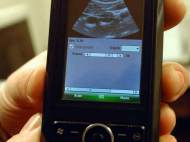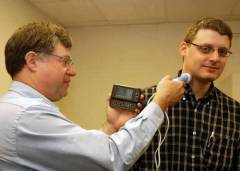A step closer to Star Trek gadgets – medical scanner
 Computer engineers at Washington University in St. Louis have developed a device that resembles the medical version of a “Star Trek scanner” – a smart phone-compatible ultrasound probe that can image the human body. William D. Richard, WUSTL associate professor of computer science and engineering, and David Zar, research associate in computer science and engineering, are bringing the minimalist approach to medical care and computing by coupling USB-based ultrasound probe technology with a smartphone, enabling a compact, mobile computational platform and a medical imaging device that fits in the palm of a hand.
Computer engineers at Washington University in St. Louis have developed a device that resembles the medical version of a “Star Trek scanner” – a smart phone-compatible ultrasound probe that can image the human body. William D. Richard, WUSTL associate professor of computer science and engineering, and David Zar, research associate in computer science and engineering, are bringing the minimalist approach to medical care and computing by coupling USB-based ultrasound probe technology with a smartphone, enabling a compact, mobile computational platform and a medical imaging device that fits in the palm of a hand.
In order to make commercial USB ultrasound probes work with smartphones, the researchers had to optimize every aspect of probe design and operation, from power consumption and data transfer rate to image formation algorithms. As a result, it is now possible to build smartphone-compatible USB ultrasound probes for imaging the kidney, liver, bladder and eyes, endocavity probes for prostate and uterine screenings and biopsies, and vascular probes for imaging veins and arteries for starting IVs and central lines.
“Twenty-first century medicine is defined by medical imaging,” said Zar. “Yet 70 percent of the world’s population has no access to medical imaging. It’s hard to take an MRI or CT scanner to a rural community without power.”
Zar said the vision of the new system is to train people in remote areas of the developing world on the basics of gathering data with the phones and sending it to a centralized unit many miles, or half a world away where specialists can analyze the image and make a diagnosis. Zar wrote the phone software and firmware for the probes; Richard came up with the low-power probe electronics design. He began working on ultrasound system designs 25 years ago, and in that span he has shrunk the electronics from cabinet-sized to a tiny circuit board one inch by three inches. The USB-based probes are 10 to 100 times cheaper than common portable ultrasound devices.
One of the applications for this gadget could be in the military. Medics could quickly diagnose wounded soldiers with the small, portable probe and phone to detect quickly the site of shrapnel wounds in order to make the decision of transporting the soldier or treating him elsewhere on the field. Another promising application is for caregivers of patients with Duchenne Muscular Dystrophy. A degenerative disease that often strikes young boys and robs them of their lives by their late 20s, DMD is a degenerative disease for which there is no cure.
In time, we can expect the development of additional accesories for compact and mobile medical platforms which could help diagnose or even recover injured people.










You’re in point of fact a excellent webmaster. The web site loading pace is incredible. It kind of feels that you’re doing any distinctive trick. In addition, The contents are masterpiece. you have done a magnificent activity on this subject!